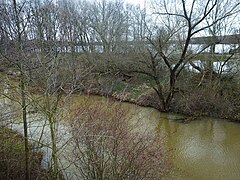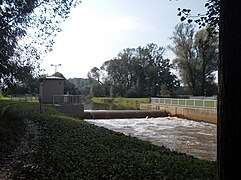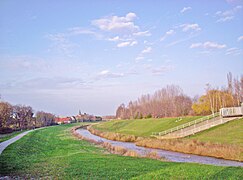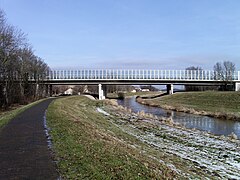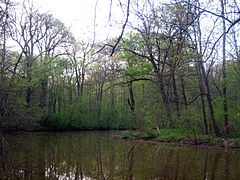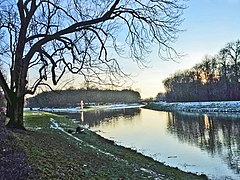Pleiße
The Pleiße is a right (eastern) tributary of the White Elster in Saxony and Thuringia . It flows into the Leipzig water junction . The river is well developed through the Pleiße cycle path .
The name Pleiße is of Old Sorbian origin and means: "the water that forms swamps" . It gave the Pleißenland (Plisni) on its lower course , which was important in the Middle Ages , its name.
course
The Pleiße has its source southwest of Zwickau in Lichtentanne , district Ebersbrunn , in the Drei-Linden-Brunnen (formerly Alboldsbrunnen). After the Saxon cities of Werdau and Crimmitschau , the Thuringian communities Ponitz , Gößnitz , Nobitz and Altenburg follow . Behind Windischleuba , the Windischleuba dam regulates the flow to Fockendorf and Treben . In Haselbach , which is still the Thuringian Pleißenaue counts follow the Saxon communities Wyke Regis , Neukieritzsch , Rotha , Böhlen , Markkleeberg before the splices finally in Leipzig over the splices flood bed and the Elster flood flows into the White Elster.
Tributaries and hydraulic structures
The course of the river originally had a length of 115 km, but was straightened and thus shortened mainly by the open-cast lignite mining south of Leipzig and is now only about 90 km in length. Between Saara and the Nobitz district of Kotteritz , its course has the status of a natural monument .
The Regis-Serbitz flood retention basin was built to protect Leipzig from flooding. It flows through the Pleiße in normal operation and has one of the longest dams in Germany . Another flood protection facility is the Stöhna retention basin near Böhlen , which was built on a residual open pit . At Rötha , the water level in the Rötha reservoir is controlled by a branch of the Pleiße.
In the second half of the 20th century, the Pleiße between Regis-Breitingen and Markkleeberg was almost completely relocated over a length of about 35 kilometers and shortened by about 10 kilometers as a result of the lignite mine. Only a 1.5 kilometer long stretch of the old Pleißenaue remained south-east of Böhlen. The new bed was mostly designed in a trapezoidal shape, interrupted by steps, and it mostly runs on narrow land corridors between the former opencast mines. When it was relocated because of the Espenhain opencast mine, the Pleißestau basin , which was laid out in 1933 between Großstädteln and Markkleeberg , which was 850 m long and 20 m wide and was intended to regulate the flow and settle sediment , also disappeared .
In Leipzig, the Pleiße at the Connewitzer Wehr divides into the partially vaulted Pleißemühlgraben and the Pleißeflood bed , which flows into the Elster flood bed about 600 m further north at the Leipziger Eck .
Up until the Pleiße flood bed was built, the Pleiße also split into two natural arms at the site of today's Connewitz weir, both of which flow into the White Elster in what is now the city area. One of the two, the Alte Pleiße or Kuhstrangwasser , was filled in in the second half of the 19th century. The second arm, the Rödel , still existed until 1926 after the interruption by the Elster flood bed and was backfilled until 1927. In 2011 the lock at the Connewitz weir was inaugurated, which creates a continuous waterway between the city and Lake Cospuden via the Floßgraben ( course 1 ) , the extension of which to Lake Zwenkau , the Harth Canal, is still under construction. In the future, the Markkleeberger See , which is already connected to the Störmthaler See , should also be accessible via the Pleiße as course 5 . The connection with Lake Hainer is planned as course 6 .
Water quality
Discharge of waste products from the carbochemical industry in the southern area of Leipzig led to discoloration, stench, strong foaming and the death of all life in the lower reaches of the river. During the GDR era, this made the Pleiße a synonym for a polluted river. The Pleiße reached 35 degrees Celsius in summer and was heavily contaminated with phenols . However, after the polluting industry was shut down in the 1990s, the water quality has improved significantly, so that numerous species of fish can now be found again. At the moment there is still a slight (non-toxic) brown coloration due to iron compounds, especially pyrite , from the water regime of the largely closed lignite mining .
Music and poetry
Johann Sebastian Bach honored the river with two works. The one, the secular cantata Schleicht, playing waves BWV 206, he composed after the poetry of an unknown poet on the occasion of the birthday of the Saxon Elector Friedrich August II. , Who as August III. was also the Polish king. In a typical baroque panegyric , an eulogy and festive speech, the rivers Vistula , Elbe , Pleiße and Danube pay homage to the prince and king. The Danube and Elbe get into a dispute over who can claim the “most lucid” ruler, the “double government sun” (his wife was the Austrian princess Maria Josepha ). The little nymph Pleiße, however, triumphs in a battle of words over the “mossy heads of strong rivers”, and the four rivers join in a harmonious hymn of praise.
In the second cantata Auf, blaring tones of the lively trumpets BWV 207a, probably performed on the prince's name day in 1735, the second movement is dedicated to her, the recitativo Die stille Pleiße plays .
"The silent Pleiße plays
with its small waves ..."
In 1736 a collection of songs with the title Singing Muse on the Pleiße was published in Leipzig . Its author, Sperontes , had compiled simple melodies and added his own texts to them. The collection was very popular and had several editions.
The Saxon dialect poet Lene Voigt has also sung the Pleiße several times, such as:
"Where the lead bläddscherd dorch's terrain
and the Gnoblauch dufded without end,
there near Leibzich in the Sumbfschen Aun
schbugn next Saxon water woman."
The run in pictures
in Langenhessen / Werdau
in Neukirchen before the dike renovation in 2005
Weir at Gaulis
near Gaschwitz
in the Leipzig floodplain forest
It flows into the Elster flood bed as the Pleisse flood bed
literature
- Hydrological manual. (PDF; 115 kB) Part 2 - Area Codes. Free State of Saxony - State Office for Environment and Geology, p. 30 , accessed on December 25, 2017 .
- Mustafa Haikal : Along the Pleiße - On the history of a river landscape. In: New Shores. Issue 6, Leipzig 2001, pp. 3–21.
- The Pleiße . In: August Schumann : Complete State, Post and Newspaper Lexicon of Saxony. 8th volume. Schumann, Zwickau 1821, pp. 396-410.
Web links
Individual evidence
- ↑ Thuringian State Institute for the Environment (ed.): Area and water code index and map. Jena 1998; 26 pp.
- ^ German Hydrological Yearbook Elbe Region, Part I 2014. (PDF) State Office for Flood Protection and Water Management Saxony-Anhalt, p. 199 , accessed on November 3, 2018 (from: lhw.sachsen-anhalt.de).
- ^ Restoration of the morphological continuity of the flowing waters in the city of Leipzig
-
↑ cf. Pleißa with Pleißenbach near Chemnitz, Steinpleis near Zwickau, Pleissing with Pleissingbach in Lower Austria, Plisa and Plissa in Belarus.
Georg Grebenstein: The Leipzig waters from the turn of the millennium to the present . In: Neue Ufer 3, p. 4, Stadt-Kultur-Projekt Leipzig, Leipzig 1995;
Ernst Eichler: Contributions to the research of old Sorbian tribal and crook names. 1. pagus "Plisni" and the river name "Pleisse". In: Contributions to Name Research 7 (1956), pp. 21–26;
see also Ernst Eichler, Gerold Hilty, Heinrich Löffler, Hugo Steger, Ladislav Zgusta: Namenforschung / Name Studies / Les noms propres. Volume 1 (= Volume 11 of Handbooks of Linguistics and Communication Science HSK), Walter de Gruyter, 1995, ISBN 978-3-11-020342-4 , Chapter 45, 1.1., P. 318, Column 2 and p. 332, column 2 ( limited preview in Google Book Search). - ↑ reminds of the water gate in the former city wall
- ^ Flussverlegungen, In: Neue Ufer - Project to uncover the Pleiße and Elstermühlgraben in Leipzig
- ^ Georg Grebenstein: The Leipzig waters from the turn of the millennium to the present , in: Neue Ufer 3, p. 30, Stadt-Kultur-Projekt Leipzig, Leipzig 1995
- ↑ Leipzig Lexicon: Rödel
- ↑ https://www.youtube.com/watch?v=J4hgui4d6Oc&t=492s/
- ^ Hans Christian Worbs: Johann Sebastian Bach: Secular Cantatas . In: Sony Classical (Ed.): JS Bach. Up, thunderous tones of the lively trumpets BWV 207a. Creeps, playing waves BWV 206. Cantatas for August III., Elector of Saxony, King of Poland . S. 12 f . (Supplement to the CD, R. Ziesak, M. Chance, C. Prégardien, P. Kooy, Kammerchor Stuttgart, Concerto Köln, Frieder Bernius, SK 46492).
- ↑ Anonymos: BWV 206 Sneaking, playing waves, and mumbling gently! In: The Bach Cantatas. Walter F. Bischof, accessed November 26, 2008 (full text).
- ↑ Anonymos: BWV 207a Up, blaring tones of the lively trumpets. In: The Bach Cantatas. Walter F. Bischof, accessed November 26, 2008 (full text).
- ↑ Lene Voigt; Gerhard Hopf: Wo de Bleisse bläddscherd ... (High German: Where the Pleiße ripples ... ). Verlag Sachsenbuch, Leipzig 1999, ISBN 978-3-910148-04-8








